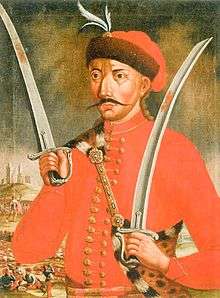Pál Kinizsi
| Pál Kinizsi (Hungarian) Paulus de Kenezy (Latin) Paul Cneazul or Pavel Chinezu (Romanian) | |
|---|---|
| Count and Captain-General | |
 Pál Kinizsi in a Romantic painting depicting him in 17th-century Hussar uniform. | |
| Coat of arms |
|
Titles and styles
| |
| Born | 1432 |
| Died | 1494 |
| Spouse(s) | Benigna Magyar |
| Religion | Christian |
| Occupation | Hungarian magnate and general |
| Memorials | Statue in Budapest by János Pásztor (1930) |
Pál Kinizsi (1432–1494), also known as Paulus de Kenezy (in Latin) or Paul Cneazul or Pavel Chinezu (in Romanian) was a general in the service of Hungarian army under king Matthias Corvinus. He was the Count of Temes County (in the historical Banat region, now part of Serbia and Romania ) from 1484 and Captain-General of the Lower Parts. He was a general of King Mathias' famed Black Army. He is famous for his victory over the Ottomans in the Battle of Breadfield in October 1479. He reputedly has never lost a battle.
Life
Origin and early life
Kinizsi's ancestry is obscure. According to some he was a son of a miller,[1] and prior to his military career, he was a journeyman miller.[2] According to some Serbian historians, he was of Serbian origin,[3][4] and was possibly a descendant of Vuk Branković, though this could not be determined.[3]
The first mention of his name is in 1464, in a Latin written document mentioning that Egrenius (His Excellency) Paulus de Kenezy receives a possession in the Abaúj County[5]. Later in 1510, appears also in form of Paulo de Kynys Comiti Themesiensi et Generali Capetaneo partium Regni nostrum inferiorum[6].
Military career
His central estate was the Castle of Nagyvázsony.
After the death of king Matthias in 1490 he supported Polish (by birth) king Vladislas II of Hungary and the great magnates against Matthias' illegitimate son and designated successor John Corvinus. He destroyed the former king's mercenary Black Army which had become a robber band after its dissolution. He then was crippled by a stroke and died shortly afterwards. He is one of the few generals of the world who never lost a battle.
Family
He married Benigna Magyar,[7] the daughter of Blaise Magyar, another general of Corvinus.
Titles
Folklore
In legends, he is known as a commoner.[9] Kinizsi is a hero of some Hungarian and Romanian folk tales along with king Matthias Corvinus as an extremely strong former miller's apprentice. According to these tales, the king was hunting in the Bakony forest near the mill where he worked and asked for a drink; Kinizsi, to show his strength, served the cup on a millstone. The king, impressed, took him into his service, where Kinizsi's strength, prowess and loyalty earned him rapid promotion. He is said to have wielded two greatswords in battle and to have danced a victory dance after the Battle of Kenyérmező with a captured or dead Turk under each arm and a third held with his hair or belt in his teeth.
Honors
Postage stamps: Pál Kinizsi postage stamps were issued by Hungary on 1 January 1943.[10] and in 1945. This same stamp was surcharged 28 fillér on 5 fillér and issued in 1945.[11]
References
- ↑ Charles Hebbert; Norm Longley; Dan Richardson (2002). Hungary. Rough Guides. pp. 284–. ISBN 978-1-85828-917-5.
- ↑ Franz Babinger (1992). Mehmed the Conqueror and His Time. Princeton University Press. pp. 374–. ISBN 0-691-01078-1.
- 1 2 László Szalay (1862). Das Rechtsverhältniss der serbischen Niederlassungen zum Staate in den Ländern der ungarischen Krone. Lauffer & Stolp. pp. 7–.
- ↑ Љубомир Степанов: Срби у Кнезу (Темишвар, 1998)
- ↑ Csánki Dezső, Magyarország történelmi földrajza a Hunyadiak korában, vol. I, p. 228, citat în Ioan Hațegan, Ligia Boldea, Dumitru Țeicu, Cronologia Banatului: Banatul între 934–1552, vol. II, partea 1, Timișoara: Ed. Banatul, 2006, ISBN 973-7837-72-3 Parameter error in {{isbn}}: Invalid ISBN. (versiune online), p. 262
- ↑ Csánki Dezső, Magyarország történelmi földrajza a Hunyadiak korában, vol. I, p. 228, citat în Ioan Hațegan, Ligia Boldea, Dumitru Țeicu, Cronologia Banatului: Banatul între 934–1552, vol. II, partea 1, Timișoara: Ed. Banatul, 2006, ISBN 973-7837-72-3 Parameter error in {{isbn}}: Invalid ISBN. (versiune online), p. 262
- ↑ Országos Széchényi Könyvtár 1972, p. 21.
- ↑ Géza Dávid; Pál Fodor (2007). Ransom Slavery Along the Ottoman Borders: (Early Fifteenth - Early Eighteenth Centuries). BRILL. pp. 4–. ISBN 90-04-15704-2.
- ↑ Peter F. Sugar; Péter Hanák; Tibor Frank (1994). A History of Hungary. Indiana University Press. pp. 72–. ISBN 0-253-20867-X.
- ↑ colnect.com/en/stamps/stamp/179984-Pál_Kinizsi_-1494-Characters_and_Relics_of_Hungarian_History-Hungary.
- ↑ colnect.com/en/stamps/stamp/253619-Pál_Kinizsi_-1494-Surcharged-Hungary.
Sources
- Kocsis, Károly; Eszter Kocsisné Hodosi (1998). Ethnic Geography of the Hungarian Minorities in the Carpathian Basin. Simon Publications LLC. ISBN 1-931313-75-X. Retrieved 2008-05-21.
- Országos Széchényi Könyvtár (1972). The National Széchényi Library. National Széchényi Library.